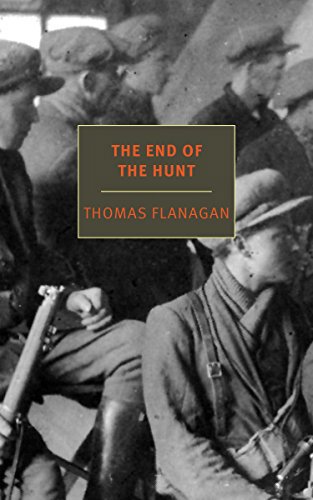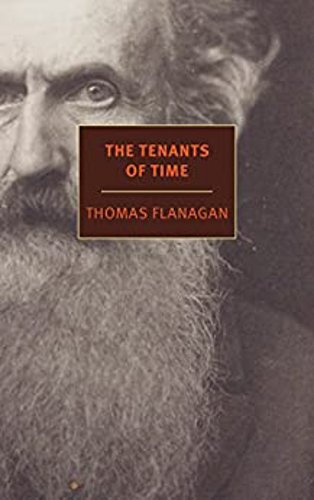Estate of Thomas Flanagan
Thomas Flanagan (1923-2002), the grandson of Irish immigrants, grew up in Greenwich, Connecticut, where he ran the school newspaper with his friend Truman Capote. Flanagan attended Amherst College (with a two-year hiatus to serve in the Pacific Fleet) and earned his Ph.D. from Columbia University, where he studied under Lionel Trilling while also writing stories for Ellery Queen's Mystery Magazine. In 1959, he published an important scholarly work, The Irish Novelists, 1800 to 1850, and the next year he moved to Berkeley, where he was to teach English and Irish literature at the University of California for many years. In 1978 he took up a post at the State University of New York at Stonybrook, from which he retired in 1996. Flanagan and his wife Jean made annual trips to Ireland, where he struck up friendships with many writers, including Benedict Kiely and Seamus Heaney, whom he in turn helped bring to the United States. His intimate knowledge of Ireland's history and literature also helped to inspire his trilogy of historical novels, starting with The Year of the French (1979, winner of the National Critics' Circle Award for fiction) and continuing with The Tenants of Time (1988) and The End of the Hunt (1994).
Flanagan was a frequent contributor to many publications, including The New York Review of Books, The New York Times, and The Kenyon Review. A collection of his essays, There You Are: Writing on Irish and American Literature and History, is also published by New York Review of Books.
"I haven't so enjoyed a historical novel since The Charterhouse of Parma and War and Peace" —The New York Times
Books
The Year of The French (The Thomas Flanagan Trilogy Book #1)
In 1798, Irish patriots, committed to freeing their country from England, landed with a company of French troops in County Mayo, in westernmost Ireland. They were supposed to be an advance guard, followed by other French ships with the leader of the rebellion, Wolfe Tone. Briefly they triumphed, raising hopes among the impoverished local peasantry and gathering a group of supporters. But before long the insurgency collapsed in the face of a brutal English counterattack.
Very few books succeed in registering the sudden terrible impact of historical events; Thomas Flanagan's is one. Subtly conceived, masterfully paced, with a wide and memorable cast of characters, The Year of the French brings to life peasants and landlords, Protestants and Catholics, along with old and abiding questions of secular and religious commitments, empire, occupation, and rebellion. It is quite simply a great historical novel.
(New York Review of Books, October 2004)
There You Are: Writings on Irish and American Literature and History
Thomas Flanagan became famous as the author of a trilogy of novels, starting with The Year of the French, about Ireland from the rebellion of 1798 to the civil war of the 1920s. But the novelist who began by reimagining the mental and physical world of eighteenth-century County Mayo had long been immersing himself, as a scholar, essayist, and reviewer, in the literature and history of his ancestral land.
In the nonfiction writings collected here, many of them unpublished in his lifetime, Flanagan brings what Christopher Cahill calls his "keen eye and strong gaze and sharp tongue" to reassessments of key figures of Irish culture. They range from Richard Brinsley Sheridan and Lord Edward Fitzgerald, through W. B. Yeats and James Joyce, Charles Stewart Parnell and Michael Collins, to contemporaries and friends like Brian Moore and Frank O’Connor, and American Irish like the Molly Maguires and the director John Ford.
Flanagan probes the tragically intertwined origins of celebrity and literary modernism in the careers of Irish-American writers such as F. Scott Fitzgerald, Eugene O’Neill, and John O’Hara. He reflects on what his own novels have taught him about the possibilities of historical fiction. And his thoughts on Irish-American identity sum up the long-pondered mixture of experience and scrutiny he brought to his heritage.
Witty, lively, and learned, this collection reveals that Thomas Flanagan was not only as a master of the historical novel but a writer who meditated broadly and deeply on the Ireland he once described as "a complex, profound, historical society, woven of many strands, some bright and some dark."
(New York Review of Books, November 2004)
The End of the Hunt (The Thomas Flanagan Trilogy Book #3)
This third volume of Thomas Flanagan’s best-selling Irish-history trilogy (which begins with The Year of the French and continues with The Tenants of Time) brings to epic life the events of the Irish War of Independence. Flanagan’s gaze is both world historical and intimate as he tells the story of Janice Nugent, a recent war widow who strikes up a romance with Christopher Blake, a historian and propagandist for the IRA; of Patrick Prentiss, discharged from the British army after losing an arm in World War I to find Dublin engulfed in civil turmoil; of a Virgil-toting gunman named Frank Lacy; and of a panorama of meticulously drawn historical figures on both sides of the conflict, from Winston Churchill and Lloyd George to Eamon de Valera and Michael Collins. While violence escalates and losses mount, the once-mighty British Empire shows signs of strain and Irish independence finally glimmers on the horizon.
(New York Review of Books, April 2016)
The Tenants of Time (The Thomas Flanagan Trilogy Book #2)
The second volume of Thomas Flanagan’s best-selling Irish-history trilogy (which begins with The Year of the French and closes with The End of the Hunt) is set at the turn of the twentieth century, though its action revisits the thrilling revolutionary period of nearly half a century earlier. It is 1904 and the young historian Patrick Prentiss is visiting rural Kilpeder to research the townspeople’s rebellion during the 1867 Fenian Rising. Drawn into the events of that turbulent year by the intimate narration of the survivors, Prentiss discovers the struggles of the Irish nationalist movement refracted in the lives of those who participated in the failed revolt and its aftermath.
(New York Review of Books, April 2016)




